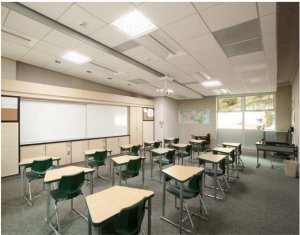 Image demonstrates the impact on windows in a renovated classroom.
Image demonstrates the impact on windows in a renovated classroom.The Prince William County School Board looked at options to bring more natural light into four of its older high schools at its Jan. 15 work session.
Superintendent Dr. Steven Walts had representatives from Moseley Architects present four different proposals on how to bring natural light into high schools. The total cost of the options for all four schools range from $47.8 million to $93.4 million.

These schools - Stonewall Jackson and Osbourn Park in the Manassas area, and Woodbridge and Gar-field in Woodbridge area- were built in the 1970s and have very few windows. They are very strong structure built to last, but their strength makes them less adaptive to modern renovations, especially Stonewall Jackson and Osbourn Park.
The other high schools in the county already have natural light. Brentsville is an older school, but has windows. Patriot and Colgan, built in the last decade, have storefront windows, court yards and other architectural fenestration features. The 13thHigh School has a similar design.
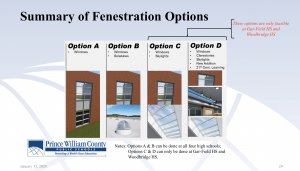 School division shows differences among the four options.
School division shows differences among the four options.Updating older high schools is something community members in those districts want. And renovations made to the older schools are very cost effective in contrast to building new high schools. The 14thhigh school is estimated to cost approximately $150 million, including its land purchase.
Moseley’s architects Billy Riggs, Vice President and K-12 Managing Principal, and Kenny Durret, Project Manager, presented a range of options to the board members, beginning with simply adding large windows around the parameter of the buildings (Plan A) to adding skylights and additions with several fenestration features (Plan D).
The proposed completion time is 2022 for the Manassas schools and 2025 for the Woodbridge schools.
Woodbridge Sr. High School and Gar-field High School, which have identical designs, have much more flexibility than the Manassas schools, allowing them to utilize any of the four plans. Additionally, even plans A and B would yield more natural light at those two schools since the Manassas schools have a very strong and rigged design.
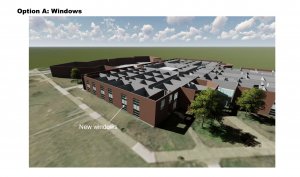 A computer rendering of the exterior of Woodbridge/Gar-field model with addition of more and larger exterior windows.
A computer rendering of the exterior of Woodbridge/Gar-field model with addition of more and larger exterior windows.Option A would add large windows all around the parameter of the schools. Existing windows that are around 2 feet in length would be lengthen to 8-10 feet to maximize natural light. Adding new windows would work for all schools, but interior classrooms would not receive any new light under this plan.
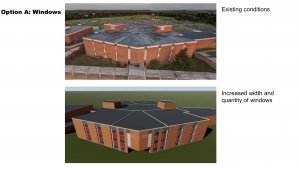 Rendering demonstrates how existing windows could be lengthened at Osbourn Park and Stonewall Jackson high schools.
Rendering demonstrates how existing windows could be lengthened at Osbourn Park and Stonewall Jackson high schools.Option A is the most cost-effective plan at approximately $12.7 million each for the Manassas schools and $11.2 million each for the Woodbridge schools. That’s a total of $47.8 million for upgrades to all four schools.
Walts said that they could begin on Plan A “almost immediately,” because there is room for the new debt in the Capital Improvement Plan (CIP) budget. The school division is limited to the amount of debt it can assume, 10% of overall revenue. Other options are not feasible without sacrificing other CIP plans or receiving more funding.
However, should the county supervisors provide more money to schools in the upcoming budget, the school division will have more flexibility in choosing plans. Walts would like to wait until he knows exactly what they will be getting next year.
 Solatube system allows natural light to flow down from the roof to the top floor ceiling.
Solatube system allows natural light to flow down from the roof to the top floor ceiling.Plan B would add the same new windows as Plan A plus solatubes on the roofs. These would allow light to flow down, providing ceiling lights via natural sunlight. The Woodbridge schools would be able to light all interior classrooms on the second floor this way. However, the Manassas schools would be limited to just a few solar tubes.
The cost of Plan B is $16.2 million at each of the Manassas schools and $20.2 million at each of the Woodbridge schools for a total of $72.8 million.
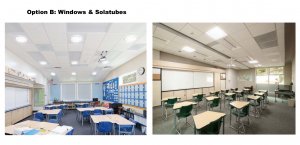 Option B would allow for windows in exterior rooms and natural light via solatubes in interior rooms.
Option B would allow for windows in exterior rooms and natural light via solatubes in interior rooms.Plan C would add skylights to some second floor interior classrooms at Woodbridge and Gar-field in addition to the windows proposed in Plan A. Using skylights instead of solatubes would bring in more natural light, give students a better view, and look more natural than the tube lighting.
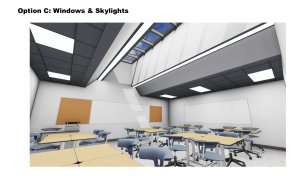 Skylights brings in much natural light and can be an attractive architectural feature in a school.
Skylights brings in much natural light and can be an attractive architectural feature in a school.Plan C would cost $17.4 million per school and could only be done at Woodbridge and Gar-field. Skylights actually cost less than solatubes. (Plan B and C) could be completed for $67.7 million.
Plan D would include the large windows on the periphery, larger skylights, clerestory windows (where the top of the walls meet the ceilings) and a new addition filled with daylight feature walls.
According to the architects with the addition, they could increase the size of certain classrooms and create a unique work space no other schools in the county have. Plan D would cost $30.5 at each of the two school. Coupled with Plan B at the Manassas Schools, would mean a total of $93.4 million.
Despite being the most expensive plan, Plan D provides more value in that it not only adds more light but creates more work space and classrooms, and allows the schools to house more students.
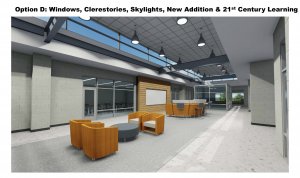 Clesterestories provide in this lounge/work space school addition featured in Option D.
Clesterestories provide in this lounge/work space school addition featured in Option D.Walts explained that when these older schools were built in the 1970s, there was not much research on how natural light affects mood and learning. Now, there has been community outcry to improve these schools. When students attend events at other schools they see the inequity and wonder why their schools do not have such modern and attractive features.
Plan C and especially Plan D require large-scale renovations explained the Moseley architects. If the school division choose option A, it would be easy to complete Plan A as phase I add the solar tubes (B) at some later time. However, if they want to go with Plan D they probably want to do everything at once since the process is so disruptive.
 A- D, this graphic demonstrates how much natural light each plan could generate at Woodbridge or Gar-field high schools.
A- D, this graphic demonstrates how much natural light each plan could generate at Woodbridge or Gar-field high schools.Walts said he prefers Option D, however, since the school board needs to stay within funding constraints and wants to move ahead quickly, he recommends Plan A. He, however, suggests the board wait to find out what kind of funding they will be getting for the coming years under the new board of supervisors.
Support Bristow Beat - Donate Today!